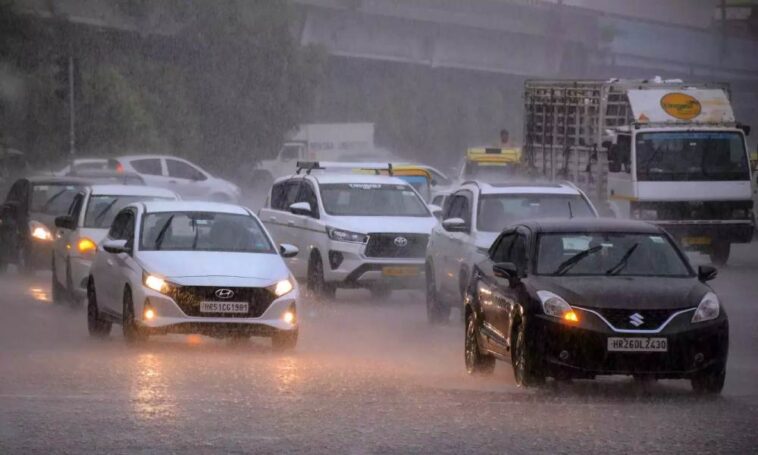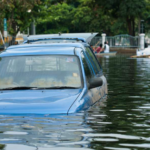How To Drive In Heavy Rain? Driving in heavy rain can be a challenging and potentially dangerous experience. Reduced visibility, slippery roads, and the risk of hydroplaning make it crucial to exercise caution and follow proper techniques. Navigating waterlogged roads requires specific knowledge and skills to ensure your safety and that of others. In this article, we will explore essential tips on how to drive in heavy rain and what to remember while driving on waterlogged roads.
Heavy rain often leads to traffic jams for several reasons. Firstly, when it rains heavily, visibility on the roads becomes poor, making it hard for drivers to see clearly and react quickly. This cautiousness causes a ripple effect as vehicles slow down, leading to congestion. Secondly, the rain makes the road surfaces slippery, reducing traction and increasing the chances of accidents. To avoid collisions, drivers tend to slow down, resulting in slower traffic flow.
Additionally, heavy rain can cause flooding in low-lying areas, forcing road closures and diverting traffic onto alternative routes that may not be capable of handling the increased volume. All of these factors combine to reduce road capacity, lower speeds, and raise the risk of accidents, ultimately causing traffic jams during heavy rainfall.
How To Drive In Heavy Rain?
Before setting off in heavy rain, it’s important to ensure your vehicle is properly prepared. Check your tires for adequate tread depth and inflation, as worn-out or underinflated tires can significantly reduce traction on wet surfaces. Ensure your windshield wipers are in good condition and replace them if needed. Moreover, make sure all your vehicle’s lights are working correctly, including headlights, taillights, and brake lights, to maximize visibility in poor weather conditions.
When driving in heavy rain, slowing down is essential. Reduce your speed to adjust to the conditions, as wet roads significantly affect your vehicle’s stopping distance. Additionally, increase the distance between your vehicle and the one ahead of you. This extra space allows for a longer reaction time and helps prevent rear-end collisions caused by sudden braking.
Things To Remember While Driving In The Rain
Maintaining visibility is crucial when driving in heavy rain. Turn on your headlights, even during the day, to increase your vehicle’s visibility to other drivers. Use low-beam headlights to avoid blinding oncoming traffic or switch on your fog lights if visibility is severely reduced. Furthermore, keep your windshield clear by regularly activating the wipers and using the defogger or air conditioner to prevent condensation build-up.
In wet conditions, sudden maneuvers can lead to loss of control and accidents. Maintain a steady and smooth driving style, avoiding harsh braking or acceleration. Gradual and gentle inputs allow your tires to maintain traction and minimize the risk of hydroplaning, which occurs when a layer of water prevents direct contact between the tires and the road surface.
Hydroplaning is a common hazard when driving on waterlogged roads. It happens when your tires lose contact with the road due to a thin layer of water between them. To minimize the risk of hydroplaning, avoid driving in the outer lanes where water accumulates the most. Also, reduce your speed and avoid making sudden movements with the steering wheel or brakes. If you do start to hydroplane, ease off the accelerator and maintain a steady course until your tires regain traction.
Waterlogged roads often have puddles and areas of standing water. Approach these with caution, as it’s difficult to gauge their depth. Even shallow-looking puddles can hide deep potholes or submerged objects that may damage your vehicle or cause loss of control. If possible, try to avoid driving through large puddles or flooded areas altogether.
Is It Good To Drive In Rainy Season?
Well, to this answer there is not any certain answer because if you have some urgent work then how can you be stay away from it. Staying informed about weather conditions and road closures is crucial when heavy rain is expected. Listen to weather reports and check for any advisories or warnings before embarking on your journey. If a road is known to be prone to flooding, consider finding an alternate route or delaying your trip until conditions improve. Planning ahead and being aware of potential risks will help you make informed decisions and ensure your safety.
Driving in heavy rain and on waterlogged roads demands extra attention, caution, and adherence to specific techniques. By following these essential tips, such as preparing your vehicle, reducing speed, maintaining visibility, avoiding sudden maneuvers, and being mindful of hydroplaning risks, you can enhance your safety and that of others on the road. Remember, it’s better to arrive at your destination slightly delayed than to compromise your well-being due to reckless driving in challenging weather conditions. Stay alert, be patient, and drive responsibly to navigate heavy rain with confidence.






GIPHY App Key not set. Please check settings